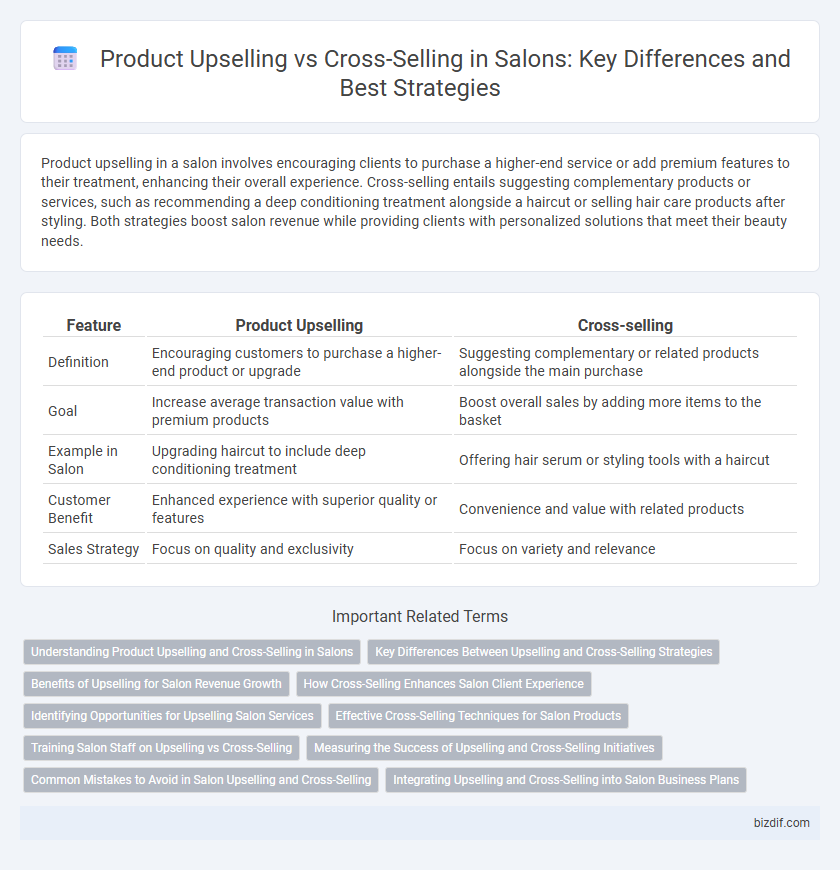Product upselling in a salon involves encouraging clients to purchase a higher-end service or add premium features to their treatment, enhancing their overall experience. Cross-selling entails suggesting complementary products or services, such as recommending a deep conditioning treatment alongside a haircut or selling hair care products after styling. Both strategies boost salon revenue while providing clients with personalized solutions that meet their beauty needs.
Table of Comparison
| Feature | Product Upselling | Cross-selling |
|---|---|---|
| Definition | Encouraging customers to purchase a higher-end product or upgrade | Suggesting complementary or related products alongside the main purchase |
| Goal | Increase average transaction value with premium products | Boost overall sales by adding more items to the basket |
| Example in Salon | Upgrading haircut to include deep conditioning treatment | Offering hair serum or styling tools with a haircut |
| Customer Benefit | Enhanced experience with superior quality or features | Convenience and value with related products |
| Sales Strategy | Focus on quality and exclusivity | Focus on variety and relevance |
Understanding Product Upselling and Cross-Selling in Salons
Product upselling in salons involves encouraging clients to purchase a higher-end or more premium version of a service or product, such as upgrading from a basic haircut to a deluxe styling package. Cross-selling focuses on recommending complementary products or services, like suggesting hair treatment or styling products alongside a haircut. Understanding the distinctions and strategic implementation of upselling and cross-selling can significantly boost salon revenue and enhance customer satisfaction by offering tailored, value-added experiences.
Key Differences Between Upselling and Cross-Selling Strategies
Upselling in salons involves encouraging clients to purchase a higher-end product or service version, such as a premium hair treatment instead of a basic one, to increase the transaction value. Cross-selling focuses on recommending complementary products or services, like suggesting a scalp massage alongside a haircut, enhancing the overall client experience and boosting sales. Key differences include upselling aiming to upgrade the original purchase, while cross-selling introduces additional, related items to the customer's order.
Benefits of Upselling for Salon Revenue Growth
Upselling premium hair treatments and luxury styling services significantly increases average transaction value, boosting overall salon revenue. Encouraging clients to upgrade to higher-end products enhances customer satisfaction and loyalty, resulting in repeat business and positive referrals. This targeted approach leverages existing client relationships to maximize profitability without the cost of acquiring new customers.
How Cross-Selling Enhances Salon Client Experience
Cross-selling in salons enhances client experience by offering complementary services such as scalp treatments alongside haircuts, increasing satisfaction and personalized care. Introducing product upselling, like premium shampoos or styling tools, further enriches client results and boosts retail sales. This strategic approach deepens client trust and loyalty while maximizing revenue potential.
Identifying Opportunities for Upselling Salon Services
Identifying opportunities for upselling salon services involves analyzing client preferences and service history to recommend premium treatments that enhance their experience. Offering luxury options like deep conditioning, scalp massages, or extended styling sessions increases revenue while improving customer satisfaction. Training staff to recognize cues and suggest complementary upgrades can effectively boost average transaction value without compromising service quality.
Effective Cross-Selling Techniques for Salon Products
Effective cross-selling techniques in salons include recommending complementary products that enhance the client's current purchase, such as pairing a shampoo with a leave-in conditioner tailored to their hair type. Training staff to suggest related items during service consultations increases the likelihood of product add-ons, improving overall sales and client satisfaction. Utilizing personalized product displays and sample testers in treatment areas encourages clients to explore and purchase multiple salon products.
Training Salon Staff on Upselling vs Cross-Selling
Training salon staff on upselling focuses on encouraging clients to choose higher-end products or enhanced services that complement their original selection, boosting revenue per transaction. Cross-selling education trains employees to suggest related items or services, such as recommending hair treatments alongside shampoos, effectively increasing overall sales volume. Emphasizing product knowledge and customer consultation skills ensures staff can personalize recommendations, improving client satisfaction and maximizing salon profitability.
Measuring the Success of Upselling and Cross-Selling Initiatives
Measuring the success of upselling and cross-selling initiatives in a salon involves tracking key metrics such as average transaction value, customer retention rate, and product attachment rate per service. Analyzing POS data to identify increases in sales of premium products or complementary services provides insights into customer purchasing behavior. Salon management software with detailed reporting features enables precise evaluation of campaign effectiveness and ROI, optimizing future marketing strategies.
Common Mistakes to Avoid in Salon Upselling and Cross-Selling
Common mistakes to avoid in salon upselling and cross-selling include pushing products that do not match the client's hair type or preferences, which can lead to distrust and lost sales. Salons should avoid overwhelming clients with too many options, as this can cause decision fatigue and reduce the likelihood of purchases. Failing to train staff on product knowledge and personalized recommendations often results in ineffective upselling and missed cross-selling opportunities.
Integrating Upselling and Cross-Selling into Salon Business Plans
Integrating upselling and cross-selling strategies into salon business plans enhances revenue by promoting premium services and complementary products tailored to client needs. By training staff to recommend personalized upgrades during appointments and suggesting related treatments or retail items, salons can increase average transaction values and improve customer satisfaction. Leveraging customer data and appointment history allows salons to create targeted offers that seamlessly blend upselling and cross-selling opportunities for maximum impact.
Product Upselling vs Cross-selling Infographic

 bizdif.com
bizdif.com